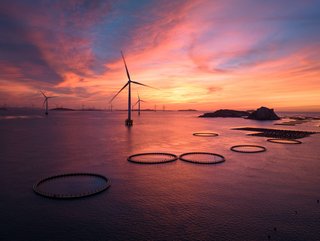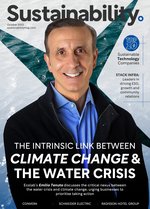VMware: Mobilising sustainability solutions

The telecommunications industry is the backbone of the digital economy, connecting billions of people to education, jobs, social media, retail and entertainment. But this connectivity comes with a significant environmental cost, as greenhouse gas emissions continue to increase with our ever-growing reliance on digital services. But hope isn’t lost. The same spirit of innovation that developed digital technologies can be used to create a more sustainable telecom industry – one that embraces mobility to shift workloads toward renewable energy sources.
The carbon footprint of telecommunications
The telecommunications industry is a major contributor to global greenhouse gas emissions.
It already accounts for up to 10% of the world’s energy usage, a number that will only increase as businesses and consumers use more digital devices and connect to more digital services. Some studies project that telecommunications will account for as much as 20% of global emissions by 2030.
But what are the key drivers of telecom emissions? Data centres burn through enormous amounts of electricity, generating as much CO2 as the airline industry. Infrastructure and data traffic associated with the proliferation of 5G is another major factor that could double—or even triple—the industry’s overall energy consumption. And we’re only beginning to grasp how artificial intelligence and machine learning solutions may push demand higher in the years to come.
These are trends that cannot be ignored. Numerous telecommunications industry leaders have committed to achieving net zero or carbon neutrality as part of their corporate strategy. This commitment represents a significant opportunity, as even small changes in this space can make a huge difference in the global fight against climate change. One study from the Global e-Sustainability Initiative suggests that the telecommunications industry can support a 20% reduction in global greenhouse emissions by 2030 if it can find ways to work more efficiently.
How can we mobilise sustainability solutions?
Reducing carbon emissions across the telecommunications industry is a challenge we’re eager to take on at VMware. As an early pioneer and global leader in virtualisation, environmental sustainability has long been a byproduct of our services. When companies virtualise their operations, they benefit from lower costs, increased flexibility, and more resilience—as well as a reduced carbon footprint through avoided emissions.
We also take our own environmental stewardship seriously. VMware is proud to be a certified carbon-neutral company powered by 100% renewable energy. We’re also going a step further—integrating sustainability into our business model and making decarbonisation and carbon transparency key features of the technology solutions we provide to customers. This means leveraging VMware’s innovative engineers and partners to drive sustainability outcomes that benefit everyone.
This shift does so much more than just help VMware achieve its own Environmental, Social and Governance (ESG) goals—it also helps our customers achieve their own. We’re like the centre of a Fibonacci spiral: when we create services that prioritise decarbonization, those benefits flow out and are amplified exponentially as customers in countless industries around the world use our products. It’s positive environmental impact at scale.
How is VMware reducing energy consumption?
When we think about helping our customers in the telecommunications industry decarbonise their operations, we’re working on several interventions that have the potential to move the needle.
Improving the energy and resource efficiency of Radio Access Networks (RAN) and data centres used by telecoms is a major priority. According to the NextG Alliance, the RAN accounts for more than half of all energy consumption in their network, while data centres are responsible for as much as 2% of the world’s total energy consumption according to some estimates.
To reduce this energy consumption, VMware is developing numerous technologies that help networks run more efficiently. We’re currently testing network automation tools that deactivate cells in the network’s capacity when traffic is light (like at night), reducing energy consumption and waste while maintaining coverage. We’re also testing solutions that can optimise the power consumption and performance of data centre cooling systems and virtualised Radio Access Networks (vRAN)—improving power usage effectiveness and reducing carbon emissions.
How can we use mobility to shift workloads to renewable sources?
Of course, reducing energy consumption is only a small part of the battle when it comes to improving the carbon footprint of the telecommunications industry. To really move the needle, we must reduce our dependence on energy generated from fossil fuels entirely.
Many telecoms and other large network operators would prefer to shift more of their workloads on to renewable energy sources. But the reality is that renewable sources like wind and solar are intermittent, and that is a major hurdle for digital connectivity. A practical solution would be to provide coverage using a mix of power sources, with the ability to prioritise renewables when possible.
On the surface, it might seem like this would require radically new technology capabilities. But the mechanics are quite similar to the mobility that VMware employs to help organisations shift workloads to different data centres when outages occur. We’re now developing new mobility tools that will help organisations increase their use of renewable power sources, respond more effectively to power grid fluctuations, and improve overall energy efficiency. Early tests indicate that this kind of intelligent workload placement and migration could reduce RAN network emissions by up to 52%.
Challenges remain—but the outlook is positive
The environmental challenges facing the telecommunications industry are significant. Fortunately, the innovation we’re seeing in green technology and mobility is extremely promising. But in many ways, technology is the easiest part of the problem to solve. Policy, culture, processes, funding, profitability, and resistance to change are the biggest barriers to reducing our collective carbon footprint.
To overcome these barriers and move the needle at scale, we will need a concerted, long-term effort from organisations around the world. The good news is that more business and industry leaders recognise these challenges and are actively working to break them down. VMware is proud to play a collaborative role in this process, and we look forward to moving our industry and the planet toward a net zero future.







